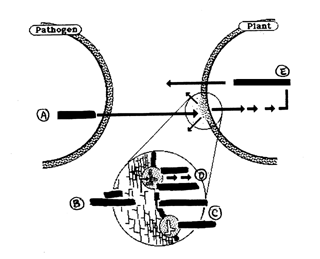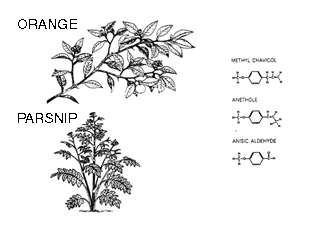 Explain what is going on in the
figure using information from this course. To enlarge this image, click on it, and
to return to the original figure with the question, click on the BACK button in your web browser.
Explain what is going on in the
figure using information from this course. To enlarge this image, click on it, and
to return to the original figure with the question, click on the BACK button in your web browser. Once you have looked at a question, you may access a brief outline of the answer by selecting the highlighted area in the question and hitting enter. Please note that these answers are longer for instructive purposes; briefer, more focused answers are usually fully acceptable.
To return to the question or to move on to the next question, simply select the highlighted question number following the answer and enter.
Please read the questions carefully and try to organize your answer before you start to write. Please try to be concise and limit your remarks to the question asked.
Each of these answers is restricted to
about 1/2 page.
1. What are secondary compounds? Explain whether or not they are essential for the lives of the plants that produce them.
2. For plant storage fats Explain the relationship between double bonds (unsaturation), melting temperature and induction of cardiovascular disease in humans?
3. Explain two examples of important medicines that are (or were originally) derived from plant secondary compounds.
4. What agrucultural impacts or uses can alleopathy have?
5. Setting aside the concerns over genetic engineering of food plants for the time being, Explain how genetic engineering of secondary compounds in food plants could improve yields, increase quality or decrease production costs. Use specific examples.
Each of these answers is restricted to
about 1/2 page.
6.
 Explain what is going on in the
figure using information from this course. To enlarge this image, click on it, and
to return to the original figure with the question, click on the BACK button in your web browser.
Explain what is going on in the
figure using information from this course. To enlarge this image, click on it, and
to return to the original figure with the question, click on the BACK button in your web browser.
7.
 The two species of plants in the figure have some similar secondary compounds.
Does this mean they must be closely related in terms of their ancestry?
What effect does this have on their herbivores? To enlarge this image, click on it, and
to return to the original figure with the question, click on the BACK button in your web browser.
The two species of plants in the figure have some similar secondary compounds.
Does this mean they must be closely related in terms of their ancestry?
What effect does this have on their herbivores? To enlarge this image, click on it, and
to return to the original figure with the question, click on the BACK button in your web browser.
Each of these answers is restricted to about 4 lines.
8. Briefly, explain the meaning (and if appropriate, give an example) of any 4 of the following 5 terms:
8e. Odors (in general chemical terms)
Each of these answers is restricted to about 4 lines.
9. Briefly, explain the function (s) of 2 of the 3 following terms:
9c.UV_absorbing pigments in flowers
Each of these answers is restricted to about 4 lines.
10. Briefly, explain the mode of action (how they work) of 2 of the 3 following terms:
Note that these answers may be at the molecular level or higher levels as seems appropriate.
Apr. 25, 2000
Do not scroll through the answers; use the links provided.
AnswerI_1
1. What are secondary compounds? Explain whether or not they are essential for the lives of the plants that produce them.
Secondary compounds are not part of the primary metabolism (e.g., Kreb's cycle, glycolysis) that is needed directly for life maintanance. Nonetheless, secondary compounds are important, even essential, for the protection, reproduction and other longer term vital functions of the plant.
Go back to question 1 or go on to question 2.
2. For plant storage fats Explain the relationship between double bonds (unsaturation), melting temperature and induction of cardiovascular disease in humans?
Natural unsaturated fatty acids occuring in fats tend to have the cis configuration, and each cis double bond causes a bend in these fatty acids. This bending decreases the ability of the fatty acids to pack together, and thereby decreases their melting temperature. Usually, unsaturated fats melt at room temperature.
For unknown reasons, saturated fats raise blood cholesterol levels in most people who eat them, whereas monosaturated fats (in modest amounts) may actually decrease it slightly. Elevated blood cholesterol concentrations generally cause fatty plaque deposits in human arteries and increase cardiovascular disease.
Go back to question 2 or go on to question 3.
3. Explain two examples of important medicines that are (or were originally) derived from plant secondary compounds.
Good examples are too numerous even to list here, much less explain all of them. Some medicines are simply made by extraction from plant sources, while others were initially isolated from plant sources, and after their structure was determined, improved synthetic versions were prepared.
Some examples:
Aspirin - analgesic - a synthetic (acetyl) derivative of salicylic acid which occurs in willow leaves and bark. Teas from willow have been used as analgesics for a long time, but salicylic acid can irritate the gastro-intestinal tract. The synthetic derivative, aspirin, is less irritating.
Morphine - a powerful analgesic derived from opium poppy latex. It has been used for several millenia and still is obtained mainly from poppy plants.
Quinine - an antimalarial drug extracted from the bark of the cinchona tree. It was discovered by indigenous, preindustrial people in S. America.
Go back to question 3 or go on to question 4.
4. What agrucultural impacts or uses can alleopathy have?
This answer does not require defining what is, but does require understanding what it is. Allelopathy is the chemically-mediated (i.e., nontrophic or noncompetitive) inhibitory effect of one plant species on another.
The agricultural impacts are of two types:
Go back to question 4 or go on to question 5.
5. Setting aside the concerns over genetic engineering of food plants for the time being, Explain how genetic engineering of secondary compounds in food plants could improve yields, increase quality or decrease production costs. Use specific examples.
This is a "wide-open" question, but it was meant to be.
One way of improving yields, increasing quality and decreasing production costs is to engineer in secondary compounds responsible for pest resistance. Throughout the term, you were given numerous examples of secondary compounds that could be used to make the crop plants more resistant to herbivores, pathogens and even competing weeds. This would not only decrease crop loss but dependence on pesticides (decreasing costs and increasing quality). Of course, this would also decrease environmental and human health problems
There are numerous other possibilities such as correcting nutritional deficiencies (e.g., raising vitamin levels or essential amino acids) or changing flower or fruit colors and scents/flavors.
Go back to question 5 or go on to question 6.
6.  Explain what is going on in the figure using information from this course. To enlarge this image, click on it, and
to return to the original figure with the question, click on the BACK button in your web browser.
Explain what is going on in the figure using information from this course. To enlarge this image, click on it, and
to return to the original figure with the question, click on the BACK button in your web browser.
These diagrams show the induction of host (plant) defenses by a pathogen. The pathogen produces enzymes (A) that break down the plant cell wall in a localized area in order to gain access to it. The released cell wall fragments (B) function as ellicitors of the defenses. These fragments bind to the receptors (C) and this causes the formation of phytoalexins which inhibit the pathogen. Basically, the plant cell is able to sense that it is under attack when it detects fragments from its cell wall, and this triggers its defenses.
Go back to question 6 or go on to question 7.
7.
The two species of plants in the figure have some similar secondary compounds. Does this mean they must be closely related in terms of their ancestry? What effect does this have on their herbivores? To enlarge this image, click on it, and to return to the original figure with the question, click on the BACK button in your web browser.
The presence of similar secondary compounds in different species does not necessarily mean they are related, though it can be one line of evidence for relatedness. Quite unrelated groups have evolved similar secondary compounds independently, and this is true for orange and parsnip. Interestingly, some of the insect species (e.g., black swallowtail) that specialize in feeding on one will also feed on the other if available. In these cases, the special phenylpropanoids (shown in the diagram) that occur in these species attract the herbivores instead of repelling them.
Go back to question 7 or go on to question 8a.
8a. Alkaloids are ring systems with an N (heterocyclic rings). They are weak bases and have a bitter taste. Examples: caffeine, quinine, morphine, cocaine.
Go back to question 8a or go on to question 8b.
8b. Gums (not chewing gum)are branched, heteropolysaccharides that form an insoluble gel (gelatinous suspension)when hydrated:
Examples: agar, pectin, gum arabic.
Go back to question 8b or go on to question 8c.
8c. Hallucinogens are psychoactive chemicals that change perception. They may be alkaloids or nonnitrogenous compounds, and they interfere with neurotransmission in various ways.
Examples: psilocybin, mescaline, scopolamine, ergot alkaloids.
Go back to question 8c or go on to question 8d.
8d. Pungency is not a taste but a sensation, a hot burning feeling in the lining of the mouth and back of the toungue. It may be caused by capsaicin in capsicum-type peppers or other compounds in ginger or black pepper.
Go back to question 8d or go on to question 8e.
8e. Odors (in general chemical terms) are volatile molecules, generally hydorphobic and low molecular weight. They are perceived by tissues away from the source.
Go back to question 8e or go on to question 9a.
9a. Polysaccharides provide protection for cells and support (cell walls) for the plant. Some polysaccharides serve as a storage function (e.g., starch), and some located on the cell surface play a role in cell-cell recognition.
Go back to question 9a or go on to question 9b.
9b. Phytoalexins defend plants against pathogens. Phytoalexins are produced by plant cells in response to attack by pathogens, and they inhibit the metabolism and growth of the pathogens.
Go back to question 9b or go on to question 9c.
9c. UV_absorbing pigments in flowers guide bees to the nectar in flowers (nectar guides) and thereby promote pollination. Unlike most other animals, bees are able to see in the UV, so these guides are visable primarily to bees.
Go back to question 9c or go on to question 10a.
10a. Tannins act by binding to proteins and/or metal ions. By these mechanisms, tannins can inactivate enzymes or inhibit other protein (or metal ion) functions. Some tannins are also powerful antioxidants.
Go back to question 10a or go on to question 10b.
10b. Siderophores are special class of ionophores that bind to Fe ions. They form a lipid-soluble complexes with Fe, thereby facilitating it's movement across the cell membrane into the cell.
Go back to question 10b or go on to question 10c.
10c. Ergot alkaloids act by interferring with neurotransmission causing hallucinations or by vasoconstriction.
Go back to question 10c or to question 1 or to the top of this exam .
Return to the Biology 415 Home Page.